Don't wanna be here? Send us removal request.
Text
Kettlebells After 50?

Kettlebells After 50? - As you get older, maintaining variety in your exercise routine is essential. While it’s easy to stick with what feels comfortable, continuously challenging your body in new ways is key to preventing joint pain, reducing injury risk, and keeping you mobile for all of life’s adventures! One fantastic way to switch things up is by incorporating kettlebells into your routine. While they may seem intimidating—especially if you have conditions like osteoarthritis or osteoporosis—kettlebells can be a powerful tool for enhancing strength and mobility. As a physical therapist specializing in osteoarthritis, I frequently use kettlebells with my clients and have seen incredible results.

Kettlebells offer unique benefits that dumbbells, resistance bands, and machines may not provide. Here’s why they’re a must-have for anyone over 50: 1. Kettlebells Improve Muscular Power Muscular power—combining strength and speed—naturally declines with age. Research suggests that by age 40, power starts to decrease, and after 60, it declines even more rapidly at a rate of 3% to 5% annually. This loss affects daily activities and overall independence.

Building power is crucial for maintaining an active lifestyle, whether you’re hiking, biking, or simply keeping up with grandkids. While adding speed to exercises may seem risky, kettlebell movements like swings and push presses help improve power safely when performed with proper technique. I’ve even had clients with spinal stenosis and knee pain progress to doing kettlebell swings! 2. Kettlebells Offer Versatility One of the greatest benefits of kettlebells is their adaptability. Unlike dumbbells, where multiple sets may be needed, just one kettlebell can provide a full-body workout. Whether you prefer working out at home or need a space-efficient option, kettlebells make it easy to stay consistent. 3. Kettlebells Engage the Entire Body Most kettlebell exercises recruit multiple muscle groups simultaneously, improving overall strength and coordination. For example: - Kettlebell Swings: Activate your hips, hamstrings, core, and upper body. - Goblet Squats: Target your legs, glutes, core, and back. - Side Step Movements: Strengthen stabilizing muscles, particularly in the hips and knees. Top 3 Kettlebell Exercises for Joint Health 1. Kettlebell Side Step Many daily movements occur forward and backward, but lateral motion is often neglected. Strengthening side-to-side movement can relieve joint pain, particularly in the hips, knees, and lower back. How to do it: Hold a kettlebell close to your chest, balance on one leg, and slightly squat. Extend the opposite leg sideways, then return to center. Repeat 20-30 times until you feel muscle fatigue, then switch sides. 2. Kettlebell Swing This movement strengthens the often-overlooked hamstrings, reducing strain on the knees, hips, and back. Strong hamstrings support knee health, making this exercise valuable for those with arthritis or degenerative disc disease. How to do it: Holding the kettlebell with both hands, hinge at your hips and let it swing between your legs. Then, squeeze your hips and drive the kettlebell forward, keeping it no higher than chest level. Perform 10-15 repetitions. 3. Kettlebell Goblet Squat Squats are essential for daily activities like sitting, standing, and getting in and out of a car. However, improper form can lead to discomfort. When done correctly, squats build crucial leg strength, protecting joints and improving mobility. How to do it: Start seated in a chair, holding a kettlebell at chest level. Stand up while keeping the weight close, then sit back down slowly. Repeat for 8-10 reps. Using a chair ensures proper hip movement. Kettlebells are a fantastic tool for maintaining strength, protecting your joints, and keeping workouts exciting. If you’re new to kettlebells or managing a condition like osteoarthritis, consulting a fitness or medical professional is the best way to prevent injury and maximize benefits. For more guidance on staying strong, mobile, and pain-free, visit Stay-Healthy, your go-to resource for expert-backed fitness and wellness advice. Cheers to strength and longevity! Read the full article
0 notes
Text
8 Yoga Poses for Better Sleep

8 Yoga Poses for Better Sleep - Ever have trouble falling asleep at night because your mind is still racing from the day and worrying about the next. You're not alone, and luckily, there are a few tricks that can help at bedtime (such as reading, drinking a hot cup of herbal tea or journaling). But if those tips aren't enough, and you're still struggling to get some shut-eye, practice a few yoga poses to try to get to sleep.

Take The Challenge For A New Improved You
8 Yoga Poses for Better Sleep
Yoga, just like any exercise, can help your mind de-stress and decompress from the day. Studies have found that those who practice yoga may present lower levels of cortisol, the stress hormone. The same results concluded that yoga had a similar effect on depression as antidepressants. What does this mean for your sleep? Well, cortisol levels have been found to have a direct relationship with your sleep. It is often harder to fall asleep with high levels of cortisol in your bloodstream. A 2019 study found that the practice of yoga had a positive effect on treating and improving insomnia.
Top eight yoga poses to do before bed

These poses are for any level of experience and easy enough for beginner yogis. While moving between these poses, remember to pay attention to your breath and where you feel most tension in your body. Breathe and try to relax if you experience any discomfort. Move through these poses for about 20 to 30 minutes before bed. Cat-cow pose

To get into this pose, start on your hands and knees. Your hands should be shoulder-width apart, and your knees should be below your hips. Take a deep breath and tilt your head towards the ceiling while also sticking up your pelvis -- this should mimic a "cow." Then, on your exhale, arch your back and bring both your head and pelvis down like a "cat." You can repeat these two motions a few times before moving on. Forward fold

This pose is as easy as standing up straight and leaning over to reach for your toes. If you are able, place your hands on the ground. If you are unable to touch your toes, you can do a half-forward fold and grab below your knees. Looking for a challenge? Try reaching around your ankles and hold. Make sure your back is straight and you are taking deep breaths. Advertisement

Bridge pose

Start by lying down on your back, legs and arms stretched out and on the ground. Take a deep breath, raise your core off the ground and shift your arms closer to your body to balance. Your knees should be at a 90-degree angle. Your hands can lie flat, or you can bring them together underneath your core. Happy baby

An easy pose to transition into after Bridge -- start this pose on your back. Lift your legs to the ceiling and out a little past your shoulders (or however far you can go). Then, grab onto the outside of your feet with both hands. Gently rock left and right to relieve tension in your lower back. Legs-up-the-wall

You will need to clear a space beside a wall for this pose. Facing the wall, lie on your back and walk your legs up high or lift your hips with your arms. Your hips can be against the wall or a little away. Once you get in a comfortable spot and you feel like you can balance, stretch your arms out beside you. This pose is great for de-stressing and improving your circulation.

Child's pose

You can start this pose by kneeling or getting on your hands and knees. Tuck your feet underneath your hips and bring your head close to the ground. Reach your hands out in front of you, stretching your spin. The further out you reach, the better the stretch will be for you. Seated twist If you are coming out of Child's pose for this next one, sit back up and extend your legs out in front of you. Cross one leg over the other, pulling the heel of the crossed leg your outer thigh. With the opposite arm, cross your body and twist yourself, pushing with your elbow on the raised knee. Twist and breathe. Repeat with the other side before moving on. Butterfly pose

From a seated position, straighten your posture and press the bottom of both your feet together. Placing your hands on your feet, attempt to press your hips as low as you can to the ground. The lower you go, the bigger the stretch. If you are looking for more of a challenge, move your feet closer to your body.

The information contained in this article is for educational and informational purposes only and is not intended as health or medical advice. Always consult a physician or other qualified health provider regarding any questions you may have about a medical condition or health objectives. Use these gentle yoga stretches to help calm your mind before bed and prepare for a good night's rest. Let us know, either in the comments or on our social media how your bedtime is after these poses. Read the full article
0 notes
Text
Foods You Can Eat Without Gaining Weight Copy

Foods You Can Eat Without Gaining Weight - Eat and not gain weight. That's the dream aye? And NOT gaining is critical when you’re trying to lose weight, right? You cut calories, exercise, and you'll cut fat. And also anything that’s crammed with carbs, sweetened with sugar or dipped in a deep fryer is suddenly a big no-no, nada, off-limits! But eating healthy & trying to lose weight doesn’t have to require deprivation. Many delicious (and healthy) foods can still be part of your dining repertoire. Some members of the produce family are so light in calories and fat that you can eat them with (relative) abandon.

Foods You Can Eat Without Gaining Weight
Vegetable love
The one category of foods that you can eat loads of without suffering the consequences of weight gain are non-starchy vegetables. Mostly any vegetable besides potato, corn and peas, you can eat endlessly, for instance. A cup of chopped broccoli or a grilled portobello mushroom contains just 30 calories and less than 1 gram of fat. You can chow down on two entire cups of lettuce and consume less than 16 calories. Because of its high water content, a whole tomato has a mere 22 calories. Cauliflower, kale, carrots and sprouts are similarly nutrient-dense and light in calories. These produce mainstays bring a few other things to the table. What makes them so incredible and so beneficial for weight maintenance and weight loss is they are high in macro-nutrients and micro-nutrients . And they’re rich in fiber. Fiber keeps your blood sugar levels stable, which helps you avoid sudden attacks of the munchies that might otherwise make you crave junk foods. 10 Healthy Foods You Can Eat Without Gaining Weight Indulge in these to your heart’s content, along with a balanced diet. - Celery - Lettuce - Watermelon - Broccoli and cauliflower - Grapefruit - Mushrooms - Berries (strawberries, blueberries, blackberries) - Kiwi - Carrots - Spinach and kale


If vegetables aren’t your favorite, you might be thinking how unappealing this way of eating sounds. But there are ways to spice up your veggies to make them more palatable. Roast them in olive oil spray, then add a blend of garlic and other herbs and spices. YUM! If you love dip, try salsa to add even more vegetables into the mix. Or blend a ranch flavor packet into plain Greek yogurt. Now you have a really high-protein, very healthy dip that you can use along with your vegetables.

What about fruit? Fruits are a different story. With most of them, you don’t want to go overboard. Grapes are a perfect example. A lot of people love to snack on grapes and could eat the whole bag in an afternoon without really thinking about it. But grapes are a high-sugar food. Keeping most fruits to a cup-and-a-half for the day is a good goal to have. The exceptions are berries (strawberries, blueberries, blackberries), kiwi and grapefruit. These fruits are high in fiber and low on the glycemic index — which means they won’t boost your blood sugar too much. Just be careful before eating grapefruit to make sure it doesn’t interact with any medications (such as statins) you take. And don’t load it up with sugar to make it taste sweeter. Filling up the healthy way If you’re looking for all-you-can-eat foods, it may be worth revisiting your entire diet to make sure it’s satisfying. When people eat the right meals throughout the day, that tends to fill them up much more, and they don’t have that constant hunger.

Many other foods pack a powerful nutritional punch for their calorie count. Examples are healthy proteins such as fish, chicken, tofu or beans, which should be part of each meal. You also want to add healthy fats from nuts and olive oil, vegetables and whole grains such as quinoa or brown rice to your meals. These foods will create satiety, and you can go longer without feeling that urge to snack, so you won’t overindulge.

Snacking on other high-protein, high-fiber foods will help to hold you over until dinnertime. A can of tuna, an apple with a tablespoon of peanut or almond butter, a handful of nuts, a cup of plain air-popped popcorn, a half-cup of cottage cheese or a hard-boiled egg all make excellent options. Though they do contain calories, they’re high in protein, so you won’t be tempted to overeat at your next meal. Drinking a glass of water or having a cup of bone broth (which contains protein in the form of collagen) might also help fill you up before a meal. Revamping your diet When it comes to dieting, the aim is not “How low can you go?” Your body needs calories for energy. Try to focus less on the numbers and more on the overall quality of your diet. The most important thing is to eat whole foods — ones that aren’t processed in a factory. Eating nothing but low-calorie foods could rob your body of the nutrients it needs, such as the calcium that keeps your bones strong. Plus it could leave you starving and have the opposite of the intended effect. Those low-calorie diets lead to blood sugar instability and harsh crashes. You’re bound to crash at some point and overcompensate with even more food than you had originally planned to eat.

When making changes to your diet, you don’t need to go it alone. It’s preferable to get some help from your primary care doctor or a dietitian. Your doctor can check your vitamin and cholesterol levels to make sure you safely embark on your new way of eating. A dietitian can assess your needs and create a meal plan that’s not only tailored to your goals but also sustainable over the long term. Can Foods Have ‘Negative’ Calories? Some fruits and veggies, notably celery, grapefruit and cucumber, have been touted as “negative-calorie foods.” The premise is that these foods are so low in calories that the very act of chewing and digesting them burns more calories than the foods contain. Hm, OOOKAY. Sounds good but, it this real? It might seem a logical assumption. After all, celery is mostly water, and a whole stalk contains less than 6 calories. For a while, drinking celery juice on an empty stomach was all the rage with dieters. But what limited research exists on the subject has pretty much debunked the negative-calorie claim. Researchers tested out the negative-calorie hypothesis by feeding celery to humans, as well as to bearded dragon lizards, and in most cases, it was a mostly BS. Bottom line: Celery certainly won’t make you gain weight, but it won’t take weight off, either. Read the full article
0 notes
Text
A High Protein Diet: Pros & Cons

A High Protein Diet: Pros & Cons - Eating protein is essential for various reasons, including muscle building, quick recovery after intense workouts, weight management, and prolonged satiety. It's no wonder that increasing protein intake has become a popular dietary goal for many individuals. In fact, according to the International Food Information Council (IFIC) 2023 Food and Health Survey, 52 percent of Americans have followed a specific eating pattern in the past year, with high-protein diets being the top choice for 18 percent of people.

Kris Sollid, R.D., senior director of nutrition communications at IFIC, acknowledges that high-protein diets have not been a prominent trend since 2018 when only 4 percent of respondents reported following such a diet. Sollid speculates that two significant factors might have contributed to the recent focus on protein. The first is the impact of Covid-19 on dietary choices, as people have become more conscious of their health and well-being. The second is the rise in availability and popularity of plant-based protein food and beverage products, catering to the increasing number of individuals embracing plant-based diets. Get Your Protein HERE!


A High Protein Diet: Pros & Cons
The IFIC survey revealed that people choose to adopt specific diets primarily to lose weight, improve physical appearance, feel better, have more energy, and prevent potential health problems. Adding more protein to one's diet can offer a wide range of benefits, especially for individuals who engage in weightlifting and intense workouts. Leah Silberman, R.D., a registered dietitian at the Medical Offices of Manhattan, emphasizes that the ideal amount of protein for a high-protein diet varies depending on factors such as age, weight, level of physical activity, and overall health. Additionally, it's crucial to avoid consuming excessive amounts of protein, as this can have potential drawbacks.
Understanding a High-Protein Diet
Protein is a vital component found in muscles, bones, skin, hair, and other parts of the body, according to the Harvard T.H. Chan School of Public Health. It plays a role in fueling several chemical reactions in the body, including the transportation of oxygen in the blood through hemoglobin. While protein consumption is beneficial, determining what constitutes a "high-protein" diet can be challenging. Sollid explains that some protein recommendations are based on the percentage of calories in a diet that come from protein, while others are based on body weight. Available On Stay-Healthy Right NOW:
A High Protein Diet: Pros & Cons
For adults, the recommended protein intake is at least 0.8 grams per kilogram of body weight each day, which is equivalent to approximately 7 grams per 20 pounds of body weight. Consuming protein beyond this recommendation would be considered a high-protein diet. Silberman offers further insight into high-protein diets, stating that one rule for the average person is consuming 1.2 grams or more of protein per kilogram of body weight. However, for individuals who engage in intense workouts and weight training, the protein intake could be increased to 1.75 grams per kilogram of body weight. To put these numbers into perspective, if someone weighs 154 pounds, consuming 1.75 grams of protein per kilogram of body weight would amount to approximately 125 grams of protein per day. Similarly, a 200-pound person would need about 160 grams of protein per day to meet the 1.75-gram-per-kilogram recommendation. Another approach to determining protein requirements is to consider the percentage of calories derived from protein. Sollid explains that protein intake can vary based on an individual's caloric needs, which are influenced by factors such as age, size, fitness level, and other variables. In this context, a high-protein diet could be defined as having more than 22 percent of daily calories come from protein. To illustrate this, an individual following a 1,500-calorie diet would aim for around 80 grams of protein per day, while someone on a 2,000-calorie diet would target approximately 110 grams of protein per day. Similarly, a person consuming a 2,500-calorie diet would strive for around 140 grams of protein, and for those on a 3,000-calorie diet, the goal would be around 135 grams of protein per day.
The Benefits of Protein
Protein offers numerous benefits that make it a crucial component of a healthy diet. One significant advantage is its impact on weight loss and weight management. Studies have shown that increasing protein intake can lead to a feeling of fullness, resulting in reduced calorie consumption. For example, a study involving overweight women found that when their protein intake was increased from 15 percent to 30 percent of their daily calories, they naturally consumed around 400 fewer calories per day. Moreover, protein plays a vital role in maintaining and building muscle mass, making it particularly important for individuals engaging in strength training. Research has demonstrated that higher protein intake can enhance muscle growth, strength, and recovery after exercise. Additionally, protein has been associated with metabolism-boosting effects, helping to increase calorie burning and support weight management. It also contributes to maintaining healthy blood pressure levels and promotes bone health.
A High Protein Diet: Pros & Cons
Understanding Protein Intake Limits
While protein is generally considered safe, it is important to note that excessive protein consumption may not provide additional benefits, and it can pose risks for certain individuals. Sollid suggests that for most healthy people, there is no need to worry about consuming too much protein. However, individuals with kidney disease or other kidney-related issues should monitor their protein intake carefully. Determining an exact threshold for excessive protein consumption is challenging, as individual tolerances can vary. Silberman notes that exceeding 2 grams of protein per kilogram of body weight may not offer any additional advantages. It is essential to maintain a balanced approach to nutrition and consider the overall composition of one's diet. Focusing solely on protein intake while neglecting other important nutrients, such as fiber, can have negative consequences. You poop a LOT!
The Downsides of a High-Protein Diet
While a high-protein diet can be beneficial when properly balanced, there are some potential downsides to consider. One concern is the risk of neglecting other essential nutrients, like fiber. Sollid emphasizes the importance of fiber, which is found exclusively in plant foods. If a high-protein diet predominantly consists of animal products, it may lack sufficient fiber, which is necessary for digestive health and maintaining a balanced diet. To address this, Sollid recommends diversifying protein choices to include more plant-based options like beans, chickpeas, lentils, peas, seafood, and soy foods. Another potential drawback of excessive protein intake, especially over the long term, is the strain it can put on the kidneys. While healthy individuals typically do not need to worry about this, those with pre-existing kidney problems or a family history of kidney disease should be cautious and consult with a healthcare professional. Additionally, it is important to stay hydrated when increasing protein intake. Silberman advises drinking more water as the body requires additional fluids to metabolize and eliminate the byproducts of protein breakdown. Inadequate hydration can lead to an increased risk of dehydration, which can have various adverse effects on overall health and well-being.
Optimizing Protein Consumption
Timing protein intake throughout the day is another aspect to consider. Silberman suggests that protein should be consumed evenly across three meals rather than concentrated in one meal to maximize its benefits for muscle repair and synthesis. However, consuming protein within an hour of completing a workout can provide additional support for muscle recovery and growth. To incorporate more protein into your diet, there is a wide range of options to choose from. Both animal and plant-based sources offer ample protein content. Lean meat, poultry, fish, eggs, and dairy products are excellent animal sources, while beans, nuts, seeds, and soy products are rich in plant-based protein. By incorporating these foods into your meals and snacks, you can increase your protein intake. It is advisable to check nutritional labels to determine the protein content of various products. For example, soy milk often contains more protein than other plant-based dairy alternatives, and Greek yogurt or Icelandic skyr generally have higher protein content than regular yogurt. So yes, protein plays a critical role in muscle building, recovery, weight management, and overall health. Incorporating adequate amounts of protein into your diet can have various benefits, especially for those engaged in intense physical activity. The ideal protein intake for a high-protein diet depends on factors such as age, weight, activity level, and overall health. While it is important to avoid excessive protein consumption and ensure a balanced diet, protein-rich foods can be included in meals and snacks to meet individual protein needs. By considering these factors and making informed choices, you can optimize your protein intake and enjoy the associated benefits for your health and well-being. Read the full article
0 notes
Text
5 Fitness Habits To Avoid After 50
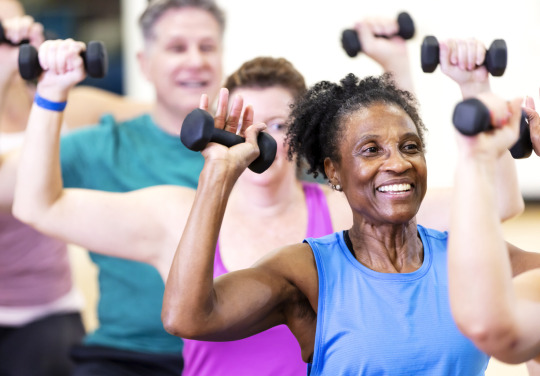
5 Fitness Habits To Avoid After 50 - The older we get the more we realize that exercise is essential for maintaining good health as we age. However, not all exercise routines are equally beneficial. Especially as we get older. Some types of exercise are more effective than others when it comes to maximizing our health-span, longevity, and independence. So, today, we'll explore five of the worst exercise habits that can potentially harm your body after 50, and we'll discuss how to avoid them.
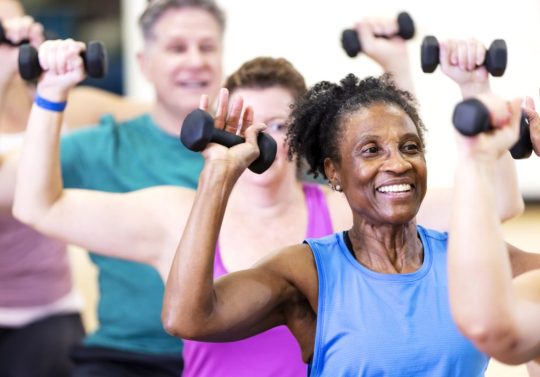
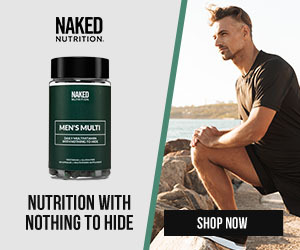
Research shows that proper exercise programs, particularly resistance training, can help reduce or even reverse some common effects of aging, such as loss of muscle mass, bone density, balance, and mobility. Therefore, it's crucial to pay attention to your exercise habits to delay or prevent these issues throughout your lifespan. However, even if you can't follow these recommendations for any reason, you should still try to exercise in some form.
Avoiding the weight room
One common mistake that many people make is avoiding the weight room. Lifting weights is a crucial part of any fitness program designed to slow or reverse the aging process. It's essential to lift weights that are challenging for a low number of repetitions, and they should feel heavy relative to your current strength. We recommend that people over 50 perform sets of six to 12 repetitions using a weight that leaves one to repetitions "in the tank" after the first set.
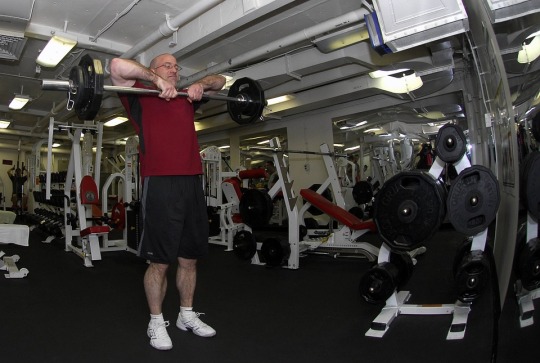
Avoiding the weights is a big mistake after 50
5 Fitness Habits To Avoid After 50
Skipping mobility work
Another mistake that people make is skipping mobility work. Mobility is a vital component of reducing injury and ensuring that your joints maintain a normal, functional range of motion. Mobility exercises can include activities like yoga, massage, foam rolling, stretching, and any other activities that incorporate some form of stretching or elongation of the muscles. Active forms of stretching, such as yoga, are usually better than passive stretching, but both have benefits. We recommend incorporating 30 to 60 minutes of mobility activities three times per week in conjunction with your weight training for maximum benefits.

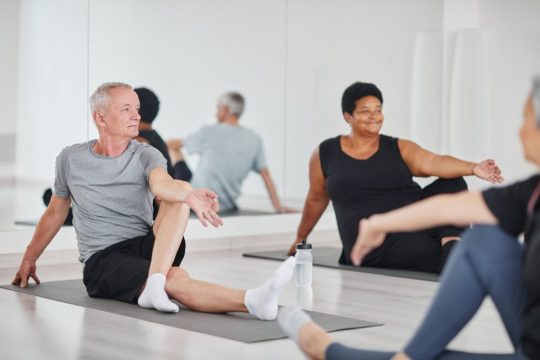
Never skip mobility exercises
Focusing too much on isolation exercises
Focusing too much on isolation movements is another mistake that many people make. Many clients focus on isolation exercises like biceps curls, triceps extensions, and leg extensions, which have a place in training, but the focus should be on compound movements that load multiple muscles and joints. Weighted movements like squats or deadlift variations that load the spine vertically provide the most benefit in terms of bones, muscle, and performance improvements.
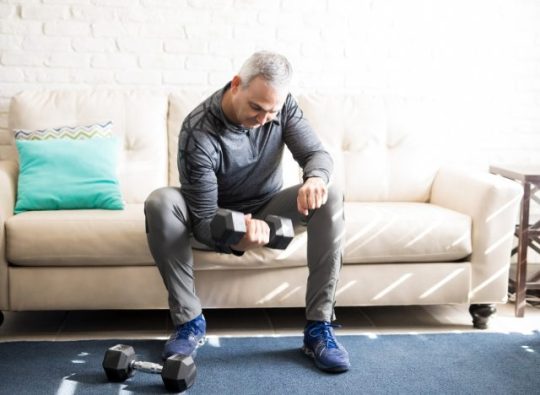
Compound movements are more important than isolating muscles
Only walking on stable surfaces
Only walking on stable surfaces is another common mistake that can harm your body after 50. While walking is an excellent addition to weight and mobility training, if you only walk on paved surfaces, you're missing out on some significant benefits. Walking on uneven surfaces such as sand, trails, rocky terrain, and other unpaved surfaces helps improve your balance and ankle strength while reducing the impact on your joints.

Hike over uneven surfaces, mountain trails
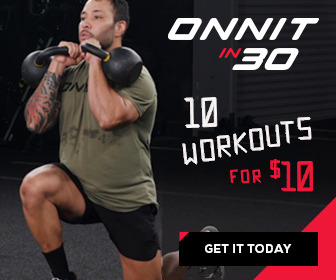

Skipping exercise altogether
Finally, the absolute worst thing you can do is skip exercise altogether. Even if you can't follow the above recommendations, doing anything is better than doing nothing. Short walks, cardio machines, taking the stairs, and other activities are still worth shooting for, even if weight training, yoga, and other methods are off the table. Take a walk and do some stretches at the very minimum. Your body will thank you now and later.

Movement, not lack of it, is key Remember, exercise is crucial for maintaining good health as we age, and it's essential to pay attention to our exercise habits to delay or prevent common effects of aging. Avoiding the weight room, skipping mobility work, focusing too much on isolation movements, only walking on stable surfaces, and skipping exercise altogether are some of the worst exercise habits that can harm your body after 50. By following the above recommendations, you can maximize your health-span, longevity, and independence, and enjoy the multitude of benefits that exercise has to offer when properly programmed. Read the full article
0 notes
Text
4 Workout Mistakes Us Old Guys Need To Fix

4 Workout Mistakes Us Old Guys Need To Fix - Yeah I said it, "..Us Old Guys...". I'm 55 and I feel it every day. What do I do? I fight back, hehehe. So, if you JUST HIT THE big 4-0 (or maybe the big 5-0, or 6-0?) and now you’re worried about things like mobility and work out longevity, don't worry TOO much. There's less reason to worry than you may think. Just because you’re 40 or 50 doesn’t mean that you’re out of your prime. Truth is, you still have plenty of time to condition your body for optimum mobility, to look better, get stronger, and even MORE athletic as you age.

What is you fitness age?

There are those people who think the day you turn 40 is the day that proverbial downward fitness and health spiral begins. That's an extreme reaction. But that’s not to say your body isn’t going through some changes, cause it is. Your testosterone is likely decreasing, and there may be a reduction in your tendon and ligament vascularity also. Injuries may be more frequent. Also, you likely find you need an extra day or more to recover after working out, especially an intense workout. Something about that number freaks out, and for good cause. You’re used to a certain level of fitness then, all of a sudden the aches and pains kick in. You find that you tire more easily. Many feel that their training needs to change and that they’re on the downswing in terms of athleticism. It doesn't need to be that way. Now, you don’t have to make massive, dramatic changes to your workouts,—but you will have to be a little smarter about your training. That includes fixing some mistakes and bad habits you might have developed.
4 Workout Mistakes Us Old Guys Need To Fix
You (only) Don't Train for Power One trap many forty & fifty-somethings fall into is to slip into a pattern of the same ole workouts, never expanding beyond the old standard of 5 sets of eight to 10 reps, while placing most—maybe too much—of their focus on elements such as time under tension.

Power is great but it's not all there is. Now, from a strength and muscle building standpoint, there’s nothing wrong with that. However, overlooking one exercise essential, training for power, cannot be overlooked no matter your age. It doesn’t have to be crazy or complicated or require endless sets of power cleans, but without maintaining some form explosive training, you will lose it, and quickly. How to Fix It: It’s no secret that we LOVE kettlebells here. So, a good start is adding an exercise like kettlebell swings into your routine. Just three sets of 10 to 20 reps, a few times a week will help you create and maintain a lot of explosive body power. You can also intertwine power training in ways you haven’t before like being more forceful with your big lifts, like maybe using lighter weight in you bench presses, squats, and deadlifts. Three sets of three to five reps will have feeling powerful at any age.

4 Workout Mistakes Us Old Guys Need To Fix
You're Training Too Heavy You may have felt good back in your high school football days (queue Al Bundy meme here – GO POLK HIGH! LOL) through your twenties loading as much weight as possible and going for your bench press max every day. Now, don’t even think about doing something like this. It does little at this point of your fitness life unless you're willing to deal with the punishment.

How to Fix It: Done over too long a period, all that heavy weight will take its toll on your joints. Your 40s are the time to begin train more comfortably in the six to eight rep range (or even eight to 10). And while creating some TUT (Time under tension) is good, you’re still able to move load, and still be joint friendly—a long-term win-win.


You Don't Do Enough Isolation Exercises We all may have noticed that modern trends push for more of multi-joint lifts than before. That CAN be a good thing, especially when strength gains are concerned. But at the same time, it’s wise for your workout to include a few complementary isolation lifts to the plan. How to Fix It: Think about adding two iso moves in each workout to help complement the deadlifts and squats and so forth. This gives you a chance to add some additional volume which in turn will help to elicit hypertrophy. If it’s leg day, then try leg extensions and curls following your squats. If back day has you doing pullups and rows, add a few preacher curls and standing curls. Hopefully, you get the idea. This will help you pile up volume without crushing your joints.
4 Workout Mistakes Us Old Guys Need To Fix
You Don't Do Enough Cardio With all the focus on weights, it becomes convenient to neglect the cardio and conditioning portion of your workouts. Not attacking that energy system isn’t very wise when it comes to longevity. Your metabolism begins slowing down after 40, so it’s critical to burn calories elsewhere. This is why it’s important to elevate your heart rate. How to Fix It: 10-20 minutes of activity is a good place to start. Whatever you're doing doesn’t have to be long and repetitive, and you can slot it toward the end of your workout. Hit the treadmill or row machine or bike and just move at a steady consistent pace. Push it a bit more oomf into it by adding 30 seconds on/off interval training as well. A long run, even picking up the weight training pace are ways to add cardio to your workout. We mentioned kettlebells earlier (of course we did). Utilizing kettlebells and your primary strength workout tool with add the cardio-conditioning element with every routine. You kill 2 birds with one kettlebell.

There's a lot of stuff when you were under 40 that you could skip. You can't skip conditioning (cardio) anymore. As long as you don't skip it. You're still going to continue to move toward your goals so avoid those mistakes and let's keep those gains happening. Hope that helps. Getting older doesn’t have to suck. Keeping fit and healthy can last well into our elder years, there’s no reason it shouldn’t. So, do yourself a favor and start incorporating these ideas into your daily fitness routines. Let us know what happens. Read the full article
4 notes
·
View notes
Text
Mobility Is Not Just About Stretching

Mobility Is Not Just About Stretching - Moving shouldn’t around hurt, at least not always. If you have what is considered a normal range of motion, you should be able to stand up, squat, walk, bend down, and reach over your head without any real effort or pain—and without having to warm up (LOL, sorry that made me giggle – reminded me of a scene from Zombie Land). Kelly Starrett is a Doctor of Physical Therapy co-author of the best-selling movement book, Becoming a Supple Leopard, and the founder of The Ready State, an online movement coaching service and gym in San Francisco. Starrett emphasizes the importance of movement and mobility to avoid pain and stiffness in the body. He discourages traditional static stretching and being “bendy” and instead prefers to talk about things in terms of mobility and mobilizing. He emphasizes that the body is “robust, tolerant, and anti-fragile,” and that the resting state of the human being is pain-free. However, the body has a “use-it-or-lose-it” policy. For example, if someone sits at a desk for hours each day, their hip flexors, hamstrings, and joints will stiffen, potentially leading to back or knee pain and trouble walking. Starrett explains that if someone doesn’t use their body in specific ways, they can lose the ability to do so. Too much typing or other computer use can impact the entire upper body.

Mobility Is Not Just About Stretching
Starrett breaks down the normal human range of motion into seven basic shapes: four shoulder shapes (arms straight overhead, straight out in front, tucked by the side of your body as if you’re about to do a press up, and by the side of your body with your elbows pulled high), and three hip shapes (a deep squat, a deep lunge, and a deep pistol squat). Every human movement is performed using some combination of these upper and lower body shapes.
Mobility Is Not Just About Stretching
If someone is struggling with everyday movements, these shapes should be considered pointers to the things that need work. If reaching overhead isn’t comfortable, they should spend time working on their shoulders. If they can’t reach down to the floor, they can target their hamstrings. When someone’s lower back or hips feel tight, the best thing they can do is spend ten minutes doing a couch stretch on each leg while watching TV.
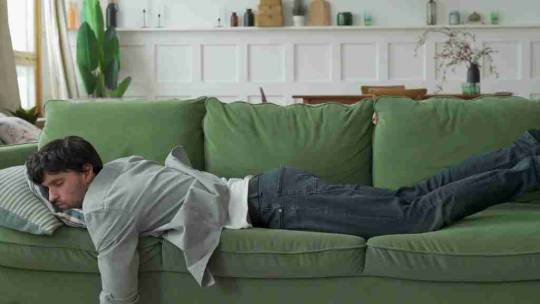
This is NOT a couch stretch....

...more like THIS woman stretching while watching TV. Starrett believes that the body should be able to do the things someone wants it to do when they want to do them, whatever they happen to be. People shouldn’t have to warm up for two hours to go to the gym or play with their kids.
Pain Is Information
"Doctor, doctor, it hurts when I do this", Doctor: "Well, STOP doing that!" One of the most important things to know is that the body is fully interconnected. If someone has back pain, the problem might be in their back, but it could also be above or below. The back is a system that’s connected to the hips, so if someone is talking about back pain but not talking about how their hips move, they’re not actually talking about the back, they’re talking about 50% of the system. You remember the old children's song, The hip bone's connected to the back bone The back bone's connected to the neck bone, The neck bone's connected to the head bone, Now shake dem skeleton bones! ANYway.... The same is true for a lot of other problem areas. If someone’s neck is stiff, they also need to look at their shoulders, upper back, and ribs. If they’re having issues when they bend their knee, the problem could be in their calf or thigh muscles. People should not focus on one area but instead work everything around it. Pain is the body’s way of telling someone that something is up. The sensation can come from an injury or physical impairment, but it can also result from tissue stiffness, not moving enough, or sitting weirdly. People shouldn’t be walking around sore every day. Working in an office shouldn’t leave someone hurting. If it does, it’s a sign that they need to address something. They should locate the problem, figure out what system it’s a part of, and find an exercise that will help. People don’t need to leave home and dedicate their lives to yoga to start working on mobility. They can incorporate these movements into their everyday life. Starrett advises to stand up every 20 minutes if someone is sitting for a long period of time. They can do a couch stretch while watching TV. They can squat down when picking something up off the floor. That means simply moving more. “We suggest 10,000 steps as the first level, but some day you’ll only get 6,000 and some days you’ll get 15,000.” Just moving and using your body more, rather than staying seated at a desk or in front of a TV, is enough to mitigate a huge number of problems. If you aren’t getting up and wandering around every so often, start doing it now. Starrett also recommends people mobilize for 10 minutes before bed. This can be as simple as getting down in a deep squat or lying on your back and stretching out, or you can take a more active approach and use a tool like a lacrosse ball or foam roller to work over any areas that are giving you trouble. Your muscles shouldn’t hurt when you press down on them or stretch them out, and you should be able to breathe comfortably while you work on things, Starrett explains. If you’re lying on a foam roller and you’re in agony, stop—you’re doing something wrong.
Find What Works for You
Starrett is a big ole strong guy. He’s a former elite athlete, runs a CrossFit gym, and throws around heavy weights. If you’re a bit of a meathead, like me (I am a Giverik or a Kettlebeller, BIG bells), his approach might work well for you. But if you find Starrett’s stuff a bit too intense, you can also check out Jill Miller’s Tune Up fitness and Sue Hitzmann’s MELT Method. Both are pretty 'mild' and a great way to increase mobility or maintain your current state of good mobility. Or just go your own way entirely. It’s your body—do what works for you. Steve Maxwell, my fitness guru, often expresses that we need to create our own workouts and fitness routines. Not everyone can, or should, do the same thing.
You’re Not Trying to Win
Moving well and without pain isn’t a game you can win. At no point can you just declare victory and say you’re done; that your knee is totally fixed and you’ll be able to hop, skip, and jump into your 90s. Modern life is always going to throw you curve-balls and you’ll need to adapt. “You’ve just got to continue to play better and feel better,” says Starrett. “This is an infinite game.” How you play is up to you. Read the full article
0 notes
Text
The Only Real Way to Detox Your Body
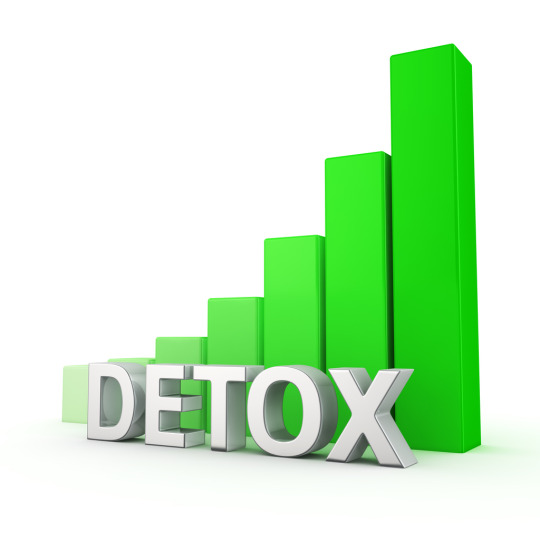
The Only Real Way to Detox Your Body - After indulging in unhealthy treats and drinks for extended periods, such as during summer BBQs or holiday celebrations, the idea of a quick fix to restore oneself to their best state becomes very appealing. Activated charcoal, green juice, herbal tea, and apple cider vinegar are touted by the internet as all that's needed for a quick detox. The detox industry is having a moment -- it is currently thriving and profitable. However, the concept of cleansing impurities from the body is not new. Ayurvedic medicine, a 2nd century BCE traditional medicine, employed a five-part detox method including medicated enemas and drug-induced vomiting. Today, our understanding of detox needs is much improved.
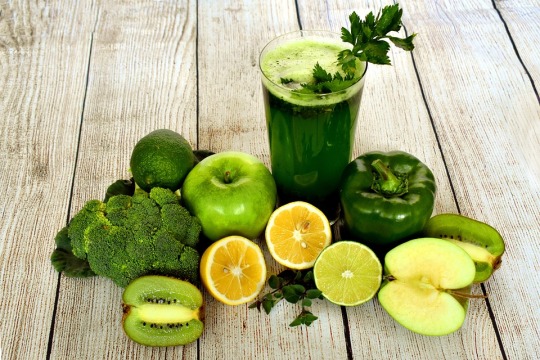
The human body has several internal systems, such as the liver, kidneys, and digestive system, that work together to eliminate harmful substances and keep the body in a state of balance. While a short-term "detox" or cleanse may provide some temporary benefits, it is not necessary for maintaining overall health and wellness. Instead, the best approach to detoxing is to support your body's natural processes by eating a balanced diet, drinking plenty of water, and avoiding exposure to harmful toxins when possible. “If your body already has a working liver, working kidneys and working lungs, your body already has the balance it needs,” says Katherine Zeratsky, a registered dietician at the Mayo Clinic. Alluring detox tools really aren’t necessary.
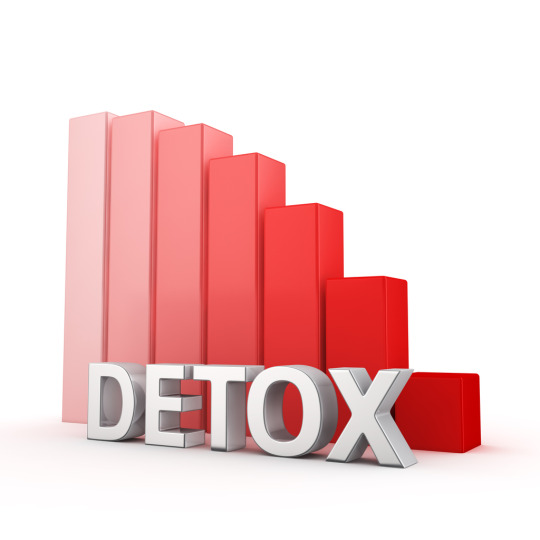

More to the point, there’s really no evidence that detoxes remove toxins from your body in the first place. While detox methods may not be effective, they are generally not harmful. However, they do come with risks. Drinking only green juice for several days can cause imbalanced nutrition but is unlikely to cause harm, according to Zeratsky. Every individual's situation is unique, as demonstrated by a woman who developed a severe kidney issue in 2019 due to a past gastric bypass surgery and recent antibiotic use while on a green juice detox diet. If you are considering a detox, it is crucial to consult with a doctor first. Additionally, do not expect immediate results as fasting or frequent bathroom trips may lead to fatigue and discomfort.
The Only Real Way to Detox Your Body
There’s also evidence that detoxing might not serve your mental health. In one Hungarian study researchers interviewed people staying in juice cleanse camps, a sort of health retreat. They found that detoxing was the number one reason cited for the juice cleanse, which was commonly paired with laxatives. Participants’ reasons for detoxing commonly overlapped with indicators of purging disorder and orthorexia nervosa, an unhealthy obsession with healthy eating. The risks to long-term mental health may therefore be worse than any immediate physiological risks.
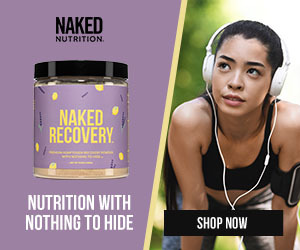
Most of the time, when people say they are looking to detox, what I actually hear is that they want “to hit the reset button,” says Zeratsky. “You can do that with good nutrition.” Cleanses and charcoal aren’t really worth the investment. So if you do want to ditch the drowsiness and rejuvenate, you don’t need to buy teas and tinctures. Try these tips instead to keep your body’s natural detox system in optimal shape.
Get Enough Sleep
First, don’t skip out on your nightly seven hours. Research has shown that your brain undergoes a natural detoxifying process in the wee hours of the night, removing harmful byproducts—like the amyloid plaques that cause Alzheimer’s—produced during a normal day of neurotransmission. But that process is only completed when you get the full seven hours of rest. Without adequate sleep your brain is slower to process information. One less hour of recommended sleep per night can also throw off your metabolism and increase your risk of pre-diabetes. Insufficient rest overall has been linked to diseases like obesity and hypertension, and seems to damage your immune system and lower your life expectancy. Nothing seems to go untouched when you skip out on the shut-eye.
The Only Real Way to Detox Your Body
Drink Plenty of Water
Water is critical for more than feeling hydrated. It keeps your bodily fluids flowing so that the lungs, kidneys, and liver can do their jobs. All bodily processes release some kind of waste, and having enough water is critical to keep blood vessels open and those byproducts flowing to the liver and kidneys where they can be filtered out. (In the kidneys, you need enough water so that extra ions, sugars, and waste products can diffuse from the blood into the kidney and eventually leave your body as urine.) But when you’re not sufficiently hydrated, your kidneys try to conserve water by concentrating your urine. In the short run, the higher concentration of waste products in your urine means you lose less water, but in the long term it increases your risk of kidney stones and urinary tract infection.
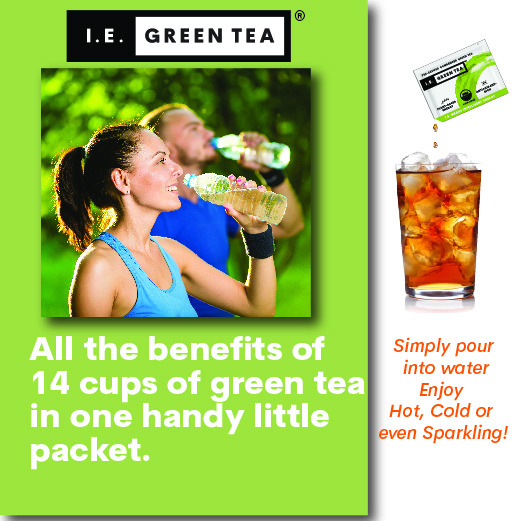
Ironically, some detox methods—like colon cleansing, which can cause cramping, vomiting, and diarrhea—can actually work against your efforts to stay hydrated. Getting rid of fluids via excessive urination or defecation just makes it harder for your liver and kidneys to function. So grab your pillow and a water bottle, and make your first purchase of the year something more fun—and effective—than a detox. Read the full article
0 notes
Text
10 Awesome Stretches For Your Back

10 Awesome Stretches For Your Back - When you work out as hard as we do (I assume you do too right?) and you’re dealing with the aches, pains and, quite often, debilitating soreness of lower-back pain, there’s a good chance all you want to do is lay down. But recent research is showing that doing a combination of strength and aerobic exercises and stretching two to three times a week can help prevent and ease lower-back pain. The nice thing about gentle stretching is that it’s feasible to do when you’re in pain—and often provides the fastest relief, and we recommend these ten stretches for the next time back pain strikes.

💡A few tips to keep in mind before you get started stretching💡 - Aim to hold each stretch for at least 10 seconds and preferably 30 seconds or even longer. The pain-relieving benefits will increase the longer you hold these stretches. - Rather than rush through the moves, we recommend turning on soothing music and using this stretching time as a chance to relax and renew. - Don’t forget to breathe! It may sound silly, but focusing on using your breath can help you cope with any feelings of discomfort. 1. Child’s Pose This common yoga pose gently stretches the muscles of the low back, which are likely contracted if you’re in pain.

How to do child’s pose: Starting in a tabletop position on all fours, place your hands under your shoulders and your knees under your hips. Extend your arms forward, flat on the floor, then slowly lower your hips back toward your heels while lowering your head and chest. Reach for the wall in front of you. If the stretch is intense, use a pillow under your belly for support and to reduce the strain on your lower back muscles. Hold the pose for 20-30 seconds or longer.

2. Cat/Cow Stretch This dynamic movement moves the low-back muscles in two directions and builds on Child’s Pose to help lengthen contracted muscles and soothe soreness.


How to a cat/cow stretch: Begin in tabletop position on your hands and knees, with your hands directly under your shoulders and knees under your hips. Your spine should be parallel to the ground in this position. Then, round your back, stretching your mid-back between your shoulder blades—similar to how a cat stretches by rounding its back. Hold for five seconds, then relax and let your stomach fall downward as you gently arch your low back and hold here for another five seconds. Repeat these movements for 30 seconds or longer. 3. Supine Twist This stretch not only helps to stretch your lower back but also your glutes, which can tighten when you're experiencing low back pain, ultimately causing more pain.

How to do a supine twist: Begin by lying on your back with your knees bent and feet flat on the floor. Extend your arms out to the side in a “T” position. Keep your shoulders on the ground as you gently roll both knees to one side. Stay here 20 to 30 seconds, then return your knees to the center and repeat on the other side. If the stretch is too much for you, place a pillow or stack of blankets under your knees when you twist to each side.


4. Knee-to-Chest Stretch Similar to the other stretches on this list, this pose lengthens contracted low back muscles.

How to do knee-to-chest stretch: Begin by lying on your back with your knees bent and feet flat on the floor. Bring your hands to rest either behind your knees or right below your kneecaps. Slowly bring both knees toward your chest, using your hands to gently pull your knees. Hold here 20 to 30 seconds, and try rocking your hips side to side and up and down to help massage your low back, then return to starting position. 5. The Pelvic Tilt When you’re suffering from lower-back pain, you might feel as if your entire pelvic area is immovable. This stretch can help you start to bring some movement back to this area gently.

How to do a pelvic tilt: Begin by lying on a yoga mat with your knees bent and feet flat on the floor. Try to relax your low back, keeping it in a neutral position (which means you should feel a slight curve in your low back if you place the top of your hand under your back). Activate your core muscles and then flatten your low back against the floor by slightly tilting your pelvis upward. Repeat 12 to 15 times.

6. Supine Figure 4 Stretch This classic yoga pose helps open up the hips as much as it is good for massaging your low back. “This pose stretches the outer glutes, as well as your piriformis, both of which can contribute to a tight lower back,” says Hilary Wright, Y7 instructor and director of continuing education.


How to do a supine figure 4 stretch: Lie on your back on a yoga mat with both knees bent and feet planted on the floor. Lift your right leg, flex your right foot and cross your right ankle over your left thigh. If this is enough stay here, or draw your left knee in and hold behind your left thigh to increase the intensity. Hold for 10 to 15 breaths and then switch to the other side. 7. Reclining Hand-to-Big Toe Stretch (Supta padangusthasana) Tight hamstrings and adductors, aka your inner thighs, can contribute to a tight lower back. This pose stretches things out by loosening up these muscles.

How to do a reclining hand-to-big toe stretch: Lie on your back and lift your right leg up towards your face. Interlace your hands behind your thigh or calf, depending on how tight your hamstrings feel. Keep your opposite leg active and your opposite hip grounded. Your head and shoulders should stay on the ground. Hold for 10 breaths. Now, still keeping your opposite hip grounded, let your right leg lower out to the right. Only lower the right leg out to the side so far as you can without the opposite hip lifting up. 8. Cow-Face Pose (Gomukhasana) This pose stretches your outer glutes, which can cause low back pain they they’re tight, says Wright.

How to do cow-face pose: From a seated position, bring your left heel toward your right glute, with your left knee pointing straight in front of you. Now bring your right leg on top of your left, stacking your knees together so they are both facing straight ahead. It’s ok if they don’t stack directly on top of one another. Your feet should be on either side of you, toes pointing behind you. Keep your spine long by sitting up tall, or add a slight forward bend to increase intensity. 9. Bridge Pose Softening around your sacrum allows some tension around the low back to be released and lengthening through the sit bones encourages activation of the lower part of your gluteus maximus, which helps to support your low back, releasing pain and tension.

How to do bridge pose: Lying on your back, bend your knees and plant both feet on the yoga mat. Be sure your feet are hip-width apart with your heels close to your glutes. Press into your feet to lift your hips. From here try to soften around your sacrum, and lengthen your sit bones toward your knees. Hold for 30 seconds. 10. Forearm Plank Wright says this variation of the plank activates your core, which will help take some pressure out of your low back by strengthening the muscles around it.

How to do a forearm plank: From the top of a push-up position, drop your forearms onto the mat directly underneath your shoulders. You can interlace your hands or bring the forearms parallel to one another, depending on how your shoulders feel. Kick through the heels and engage your core. Hold for at least 30 seconds, working your way up to one minute. So, work these into your daily routine to ease that back pain and increase flexibility. Leave your recommendations in the comments below. Read the full article
0 notes
Text
What Is Your Fitness Age?

Returning to the gym after a long break can make your body feel older than it really is, but it turns out this isn't just in your head. You can have a "fitness age" that greatly differs from your actual age. It can predict longevity perhaps even better than your chronological age can, and can give you a sense of how well your body is running. But, what exactly is a fitness age and how do you find out what yours is?
What is a fitness age?
Health researchers at the Norwegian University of Science and Technology are behind this concept. The university's Cardiac Exercise Research Group (CERG) has spent years researching physical activity and how it relates to lifespan, and have found that a person's fitness age is an important marker of health. Unlike your actual age, it is largely determined by your VO2 max- a measurement that determines how well your body uses oxygen. Also, let's abbreviate it and call it "F.A.", okay?

Cycling is great exercise.
How is a fitness age calculated?
Calculating your precise F.A. requires "specific equipment, personnel, time, and knowledge," making it largely inaccessible for most folks. That's why the CERG researchers made calculating your approximate F.A. easy and doable from the comfort of your couch. They developed a Fitness Calculator that determines your VO2 max based on an algorithm that uses individual information including age, weight, gender, resting heart rate, and physical activity level. Once you input all your data, the Fitness Calculator will give you an estimated F.A. It also will let you know if your F.A. is on par with others in your age bracket.

What does your fitness age mean?
If your F.A. is higher than your actual age, it may be a good time to look at some of your lifestyle habits and see where you can make improvements. Your F.A. can help predict your risk of heart disease and longevity, among other things. The Norwegian team behind fitness age research published a study in 2014 that found those with F.A.'s higher than their actual age had an increased risk of dying prematurely compared to those with a F.A. lower or on par with their actual age.
How can you improve your fitness age?
To improve your F.A., you can focus on exercises that help increase your VO2 max. Aerobic exercise like running, rowing, biking, or anything where you get your heart rate up for a sustained duration, are typically the best ways to test just how much oxygen you can use. Additionally, by improving your lifestyle habits, you can also improve your F.A. By eating a healthy diet, getting enough sleep, and managing stress levels, you can ensure your body is running at its best.


Bottom line is, understanding your fitness age can give you a sense of how well your body is running. By focusing on exercises that increase your VO2 max, and improving your lifestyle habits, you can improve your fitness age and ensure a better quality of life. Read the full article
0 notes
Text
Stop Doing Wrist Curls And Do This Instead

Stop Doing Wrist Curls And Do This Instead - "I yam what I yam!" This is a direct quote, LOL, from the forearm king himself, Popeye the Sailor. Now while Popeye's forearms are the stuff of legend, relying solely one wrist curls and other traditional forearm exercises isn't the best way to achieve success in that area. Forearm training is often overlooked by weightlifters, yet it plays a crucial role in achieving a well-rounded and proportionate physique. However, relying solely on wrist curls for forearm training is not an effective or efficient approach. Despite the popularity of wrist curls in weightlifting, there are plenty of better options for forearm training that will lead to greater results. Wrist curls are often seen as the go-to exercise for forearm training, especially for those who are new to weightlifting. However, these exercises are not as beneficial as they may seem. They only train one dimension of the forearm, the flexion, and fail to work the other muscles in the forearm. This can lead to a lack of stability and strength in other positions and can even cause issues such as tendonitis in the long run.

Additionally, wrist curls reinforce bad form during biceps curls. When you do a wrist curl, you reinforce wrist flexion, which is bad practice for your standard curls, as you'll take the focus off the target muscle. This means that your standard arm-day routine plays a more significant role in developing your forearms than what the one-dimensional wrist curl provides. Another issue with wrist curls is that they fail to adequately load the forearms. Forearms can, and should, be able to take on a heavier amount of weight from time to time to challenge both your forearms and grip strength in a much more effective way. Wrist curls are overrated and should be avoided as the sole means of forearm training. Instead, focus on exercises that work all dimensions of the forearm, such as extension and stabilization, and also challenge your forearms and grip strength with heavier weights. With a well-rounded approach to forearm training, you can achieve the Popeye-like forearms you've always wanted.
3 Alternative Exercises to Train Your Forearms
Biceps and Hammer Curls
3 sets of 10 to 12 reps Yes, curls do more than just blow up your biceps. By maintaining a strong, firm, and neutral grip with each curl rep, you’re creating a ton of forearm work to go along with your normal biceps training. Two curls in particular—the hammer curl and EZ-bar reverse curl— hit those areas of your forearms most neglected by wrist curls. So grip “with intent” during your next biceps session (and every workout after). “Your forearm is working at different points throughout the curl,” Samuel says. “It has to essentially correct and make sure it maintains that neutral position. That can be a lot more work for your forearm and it's gonna give you a good forearm pump as you’re pumping your biceps, your brachialis, or whatever you’re working.”
Bottoms-Up Clean and Twist
https://youtu.be/CdIXGCszHOM 3 sets of 6 to 8 reps Not only will this kettlebell move require you to focus on forearm strength, you’ll also be working on increasing shoulder stability. You won't necessarily be able to load as heavy a as some other movements, but it's still well worth your while. By holding the kettlebell in an upside-down position, the wobbling of the weight is going to force your wrist to maintain a vertical position to keep the bell upright. This will require plenty of forearm power to achieve. The twist from this position is going to add an additional piece of dynamic and fun forearm challenge that you don’t get from curls.
Farmers Walks
3 sets of 40 second walks (or holds) Anyone who ends their conditioning with a few sets of this exercise knows that the first thing that gives out is usually your grip, which makes this move a must for forearms training. Best of all, farmers walks can be done with almost any piece of equipment—barbells, dumbbells, kettlebells, trap bar, you name it. Just load, lift, grip, then move (or simply march in place or stand and hold as an alternative) as far as you can for a set amount of time or distance—or till you cant hold anymore. I'm always about "does this transfer over to anything in life?", and there's so many things in life that that carries will translate into, and it's just going to help you in the long run. Also, try the exercise with only ONE SIDE loaded (only one weight) for an exceptional core workout as well.
Stop Doing Wrist Curls And Do This Instead
Read the full article
1 note
·
View note
Text
5 Pillars Of Fitness For Life

5 Pillars Of Fitness For Life - Want stellar health and a killer physique without the forced-march workouts? Get some skin back in the game with these 5 pillars of fitness for life! So, picture this: A 55-year-old grandfather of eight is hanging from a pair of bungee cords 15 feet in the air, preparing to launch himself toward a pipe suspended 6 feet away. At 55? Yup... This is the scene at the 2019 Oklahoma City finals of American Ninja Warrior, and Jon “Rockman” Stewart is tackling Bungee Road, an obstacle that has humbled several competitors half his age. The sinewy 145 pound man hurls himself into empty air, floats, locks onto the beam, swings a few times, and dismounts. The crowd cheers and whistles. The eye-popping move secures the Utah-based construction manager a trip to the show’s national finals. Stewart says he came by his fitness naturally. “I got my core strength from working our family farm as a kid in Idaho,” he says. His ripped upper body and never-quit legs were forged from 20 years of scrambling up rock faces and frequent, rigorous mountain bike outings. In other words, Stewart sculpted his incredible physique and athleticism by following his bliss. He’s not alone. People are coming at fitness from all these different angles now. Online videos have led to an exciting cross-pollination among fitness tribes. CrossFitters are doing parkour and MMA; distance runners and triathletes are trying Olympic lifting. This newly omnivorous approach to staying in shape highlights an element that’s often missing from exercise programs. In the pursuit of ripped abs and flagstone pecs, many of us have lost sight of that most essential property of physical recreation—fun. Maybe it’s time for you to find a plan that can give you the body you want without it feeling like forced labor. A plan that’s both engaging and effective, a challenge for your brain and biceps alike. Submitted for your approval: the new pillars of lifelong fitness. 1. Quit Obsessing Over How You Look Forty years ago, during the Pumping Iron era, fitness was defined by how you looked in a Speedo (yikes! Remember those??). If you didn’t have softball biceps and single-digit body fat, you had no business calling yourself fit. Today most guys realize that getting super jacked and lean is difficult to do and takes years. A recent NCAA analysis found that single-digit body fat is rare, even among elite athletes in their prime. For example: The average body fat percentage for running backs at the NFL Combine from 2006 to 2013 was nearly 12 percent. Indeed, extreme leanness and muscularity—the kind you see in supplement ads—is not only an unrealistic goal for most busy guys but also unnecessary for athleticism. Stop staring in the mirror and focus on performance instead. Work on nailing your first pull-up, then your first five. Try cracking 21 minutes in a 5K, then 19. Conquer a 5.2 rock face, then a 5.3. Train for Performance Consider the fitness journey of Scott Ferrara, 42, a teacher in Los Angeles. “In my 20s, my goal was to be as big as possible. I was in pain. I was eating 10 chicken breasts a day. It wasn’t enjoyable.” Ferrara eventually switched gears. He completed an Olympic-distance triathlon and then participated in numerous obstacle course races on the West Coast. Now that he’s more concerned about his finishing times than his arm circumference, he’s respecting his limits. “I check in to see what my body needs on a given day,” he says. Ironically, Ferrara says he looks better now than he did when he was pumping iron—a common result of switching to performance training. “Aesthetics are best obtained from training for performance,”says Mark Rippetoe, the author of Starting Strength. “Form follows function.” 2. Do Anything But Nothing Some fitness hucksters believe that certain approaches work because they resemble the activities of our forefathers. Nonsense, says Daniel Lieberman, Ph.D., a professor of human evolutionary biology at Harvard. “Prescribing fitness and diet regimens based solely on what our ancestors did is rife with logical problems... We also evolved to sometimes fight, lie, get anxious, age, and die.” In fact, science suggests that you can get healthier, stronger, and fitter by following any plan regularly. The CDC recommends 150 minutes a week of moderate-intensity aerobic activity, along with twice-weekly muscle strengthening sessions. It’s not a high bar, but 76 percent of men don’t reach it, the CDC reports. That’s despite the fact that “moderate exercise” covers abroad array of activities, from jogging and yoga to martial arts and rock climbing. It even includes some activities many jocks might consider too easy. “Brisk walking on its own is great for health,” says David Katz, M.D., Ph.D., director of Yale’s Prevention Research Center. The best exercise, he says, is the exercise people actually do. Seek Simplicity and Proximity The simplest rule: do something every day. That’s not easy. For documentary filmmaker George Kunhardt, 29, that lesson came a bit later in life. “I was an athlete in high school, but when I got to college I partied a lot.” By the time he started his career, his weight was normal but his body was soft. That’s when Kunhardt discovered a CrossFit gym near his office. The key variables to its appeal were proximity and simplicity: He could walk there and do the workout that was posted on the blackboard. Now Kunhardt trains six days a week; his body is harder and he can bang out sets of 40 unbroken pullups. He’s rediscovered both his competitive fire and his love of fitness. “It’s my number one stress reliever. When I’m at the gym, I go to my happy place,” he says. So if you simply do anything active for 30 to 45 minutes a day, says Dr. Katz, your health will benefit. You will also likely enhance your quality of life and longevity. Of course, strategically varying the intensity of your activity will impact your results. That’s why we have Pillar 3. 3. Train, Don't Exercise Photo by technotr/Getty Images To a strength coach, exercise and training are as different as chalk and cheese. “Exercise is something you do today because of how it makes you feel today,”says Rippetoe. “Training is a planned process to achieve a result somewhere down the road.” Most gymgoers are exercisers, says Rippetoe. They might hit chest and tris on Monday, run a few miles on Tuesday, and shoot hoops on Thursday. Each workout bears little relation to the one before or after it, so their progress is minimal. Yes, it’s infinitely better than nothing at all. But to improve your performance at a particular activity, you need to program a performance increase for that activity consistently. “I don���t want my muscles to be confused,” he says. “I want them to know exactly how I want them to adapt.” Set Multiple Goals An effective exercise routine is shaped by specific goals—short-term as well as long-term—toward which every workout is a distinct stepping-stone. That often requires taking the long view. “Let’s say you want to run a 10K. You might have five obstacles you need to overcome before you can complete that goal,” says Alex Viada, C.S.C.S., of Complete Human Performance in Durham, North Carolina. You may need to address your mobility or body composition before you can start thinking about your running pace. But even if you have a long way to go, Viada says, just ask yourself what you can do now to bring each goal a little closer and make the big goal easier. Then get to work on that—consistently—one workout at a time. 4 . Change It Up Photo by PhotoAlto/Sandro Di Carlo Darsa/Getty Images Here's the curveball: To make that progress, you need to take strategic recovery breaks. “A lot of activities that we think are helpful are not,” says Andreo Spina, D.O., a chiropractor and mobility expert. Among these are some of our favorite pastimes. When major league baseball coaches and trainers ask him how to prevent elbow injuries in their pitchers, Spina tells them, only half jokingly, “Have them play another position.” From baseball and basketball to swimming and track-and-field events, sports are “man-made” activities, Spina argues. Many of them place asymmetrical demands on the body. Tennis and squash, for example, tax one arm and shoulder while leaving the other mostly out of the action. Swimming works your upper body more than your lower, while running and cycling do the opposite. The potential damage isn’t limited to knees and ankles. A study in the Journal of Applied Physiology revealed that the heart valves of lifelong runners showed elevated risk of failure. Sure, sports belong in your training program, but focusing on a single sport or activity—year-round, with no time to heal and rebalance—might hurt you. For most of us, the ideal strategy is a three-weeks-on, one-week-off plan. For three weeks, gradually increase your workload at your activity of choice. Do more sets, reps, and weight if you’re into strength training; more distance or speed if you’re a cyclist or runner; more height, speed, or difficulty if you’re a climber. Then ease off for a week and come back to focus on a slightly different microgoal. HIIT Your Target “If you’re a runner, you might plan a block where you do hills, another where you do speed or track work, and another where you work on endurance,” says Matt Dixon, a former pro triathlete and the founder of purplepatchfitness.com.“Even that simple change of stimulus will yield bigger results than just working randomly,” he says. Reams of research have shown that one approach worth most guys’ time is high-intensity interval training, or HIIT. This involves multiple short bursts of super intense exercise (like eight rounds of 30-second bike sprints) separated by periods of low-intensity movement or rest (like 90 seconds of easy spinning). HIIT has many proven advantages over steady-state cardio. The workouts are short and adaptable, challenging both your aerobic and anaerobic energy systems and burning fat more effectively. Plus, most guys think they’re more fun. In a 2011 study, just three 20-minute HIIT workouts a week measurably improved participants’ body composition, metabolism, and cardio fitness. The one downside? You might work too hard, too fast—especially if you choose a high-impact exercise like sprinting. Avoid exhaustion and injury by doing bodyweight exercises only once a week. Squats, pushups, and step ups work well—30 seconds on, 30 seconds off for each, followed by a 2-minute rest, for 5 to 10 rounds. Try 50-meter swim sprints on another day (10 reps, resting for as long as it takes to complete 1 rep). Another day you could do hill sprints on a grassy surface (do 10 and then walk down the hill to recover). Bored or excessively sore? Just abbreviate your work periods, or do mobility exercises during your rest time. 5. Listen to Your Body Photo by Mike Kemp/Getty Images Two years ago, John Short, a 60-year-old professor at Cal State Fullerton, was a chronic overexerter. He’d play 90 holes of golf over a weekend, jump into pickup basketball games, and power through sets of burpees—with a 40-pound vest—just to see if he could do it. Sometime between his umpteenth acupuncture treatment and anti-inflammatory injection, Short got wise. “When you’re in your late 50s, you have to walk a fine line between pushing enough and pushing too far,” he says. He dropped the weighted burpees, hooked up with a trainer, and replaced running with rucking—walking with a weighted pack. He’s currently gunning for an injury-free, top 10 finish in a Spartan race. He’s training smarter. “So many guys my age get hurt and pack it in,” Short says. The answer isn’t to give up altogether; it’s to adjust your routine. Exercise is dose-dependent medicine—your body thrives on just enough of it. “Beyond a certain point, there is actually net harm from extreme exertion,” says Dr. Katz. Dialing It Back Can Be Smart How do you find the sweet spot? Make sure your workout feels like work. Lifting to “volitional fatigue,” the point at which you can’t do any more reps while maintaining good form, is a more significant factor in determining muscle growth than weight lifted or reps performed, a new study reveals. “As long as you work to fatigue, it doesn’t matter whether you’re lifting 125 pounds 25 times or 250 pounds eight times,” says study author Stuart Phillips, Ph.D., a professor of kinesiology at McMaster University. Hard work leads to progress, regardless of the load lifted. To determine when you’ve reached your limit on a workout or activity, try the toe-touch test: Before your workout and between sets (or sprints or rounds of golf or sets of tennis), bend forward and reach for your toes. “If the movement you’re performing agrees with you, you’ll find that your range of motion will increase,” says David Dellanave, C.S.C.S., a Philadelphia strength coach. Feeling looser and being able to reach farther means your body is green-lighting that exercise. If, on the other hand, you get tighter (you can’t bend forward as far), then adjust, move on to a new exercise, or towel off and head home. Skipping a set or two in a planned work-out sounds heretical to some hard-core gymgoers. Dellanave disagrees: “Unless you’re a competitive athlete, there’s no need to do any particular exercise in a training session,” he says. Your mission, then, is to put these rules together to figure out your perfect training plan. It starts with doing things consistently (Pillar 2). Fine-tune with Pillar 4. Choose a range of activities in a variety of intensities: two or three days of higher-in-tensity activities (sprints, heavy lifting, climbing, or body-weight strength circuits) coupled with another two or three days of easier stuff, like hiking, jogging, or cycling. Track a few metrics, such as distance covered, weight lifted, and reps completed so you know when you’re get-ting better (as per Pillars 1 and 3), and use those stats to determine if you should go hard or go home (Pillar 5). Finally, whenever and however you can, whether it’s part of a formal workout or not, just play. Shoot hoops with friends, toss a ball with your kid, make like a ninja on the monkey bars. “Pick something you like and go for it,” says Stewart. “If you don’t have a smile on your face when you’re working out, you’re doing something wrong.” Read the full article
0 notes
Text
Develop core strength and full-body muscle with just six moves

Develop core strength and full-body muscle with just six moves? How? Well, this six-move kettlebell session strengthens your core and boosts your metabolism. And it will do it in just 22 minutes. Whether you're short on time or like efficient routines, you can build full-body strength in as little as 22 minutes with this six-move kettlebell workout. You only need a bit of space and a single weight to start. If you enjoy working out with weights, investing in one of the best kettlebells (opens in new tab) on the market is a good idea, especially as all of our top picks are reduced in this year's New Year sale.

Buy your next kettlebell here...
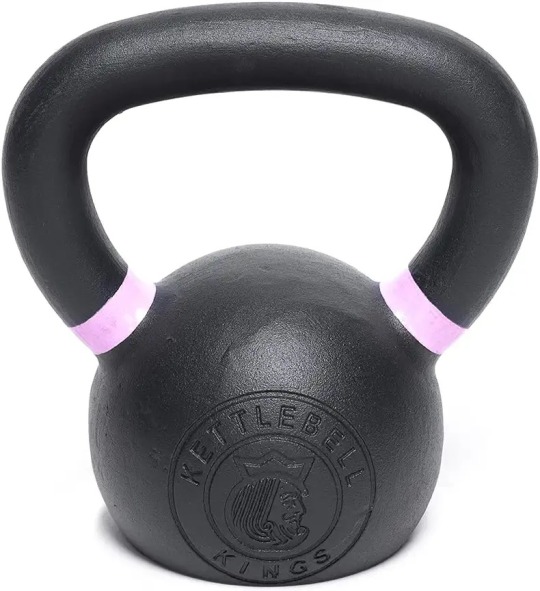
All sizes, colors and FREE SHIPPING! These off-center weights are ideal for building muscle, increasing your heart rate and boosting your metabolism, especially if you learn how to do kettlebell swings. But there's more to kettlebell training than this one (albeit very effective) exercise. This routine from the awesome fitness duo Twice The Health (opens in new tab) keeps things a bit more varied, packing six moves into a 22-minute session. It's split into two sections too; a 10-minute AMRAP (As Many Rounds As Possible) workout and a 12-minute EMOM (Every Minute On the Minute) session. So, you can perform them one after the other or just pick one if you're really short on time. If this is the first time you've come across these training styles, the aim of an AMRAP workout is to do as many repetitions of the prescribed exercises as you can in the allotted time. For this session, do 8-10 repetitions of each move before starting on the next. Then, keep repeating this three-move circuit until the 10 minutes are up. For the second section, set a 12-minute running clock. Perform eight repetitions on each side of the body of the first movement (suitcase deadlifts) then rest until the timer hits 60 seconds. In the second minute, do the same for the single-arm bent-over rows, and in the third copy this format for plank drags. Complete four rounds to reach the 12-minute finish line. As this is a high-intensity routine, it's essential to focus on your form, so watch Twice The Health's demonstrations before starting to perfect your technique. View this post on Instagram A post shared by Twice The Health (@twicethehealth) Read the full article
0 notes
Text
Lose fat and gain muscle in 8 months, even at 50+!
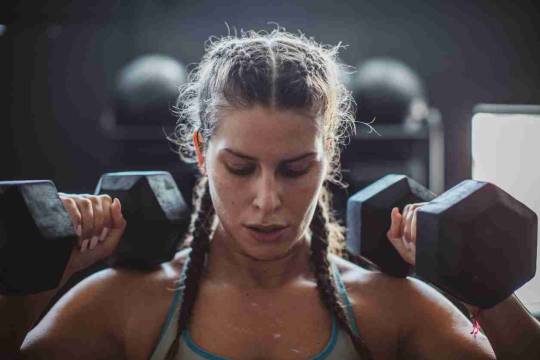
Lose fat and gain muscle in 8 months even at 50+! That's what Haylee Corron did when she walked in to the gym, and sought help from personal trainer Stefanie Tsengas. Taking your time to lose fat is essential to keeping it off, especially for those of us 50 and over! - Personal trainer Stefanie Tsengas said she helped her client Haylee Corron burn fat and build muscle in eight months. - Tsengas first had Corron master the basics and then make small progress every week, she said. - She said she divided workouts into push, pull, and leg exercises to hit every part of the body. 21-year-old Haylee Corron was unsure of herself when she first walked in the gym, according to personal trainer Stefanie Tsengas. The Cleveland-based trainer said in their first meeting a year ago, Corron was insecure about how to start an exercise routine, but wanted to lose fat, build muscle, and gain more confidence in her body. Tsengas said she used Corron's goal to create a twice-a-week workout plan that would hit the entire body and then built gradually on it to get best results. Corron said Tsengas often pushed her past her comfort zone, but showed her just how capable her body was. Not only did Corron exceed Tsengas's expectations at eight months, she also gained the confidence to consistently go to the gym on her own two to three times a week in addition to their sessions together. Stefanie Tsengas
Corron first mastered the basics
As someone new to the gym, Tsengas said Corron's initial program focused on mastering the technique of basic exercises. She said she started Corron mostly on machines because they help stabilize your body and are easier to perform correctly. Tsengas met with Corron two days a week, which she said is the average amount most people commit to. Since Corron wasn't looking to build a specific muscle, Tsengas said she divided her workouts into push, pull, and legs, an effective way to make sure you're hitting every part of the body. Corron did push and pull exercises one day, Tsengas said, and legs on the other. Push exercises mostly target the chest, shoulders, and triceps. Tsengas started Corron with push exercises like the chest press, chest fly, shoulder press, dumbbell lateral raises, front raises, rear delt fly, and cable tricep push-downs. Tsengas said that pull exercises mostly hit the back and biceps. She said lat pull-downs, single-arm dumbbell rows, pull-ups, and bicep curls were all a part of Corron's initial program. A leg day for Corron included exercises like squats, hip thrusts, lunges, leg extensions, and leg curls, she said.
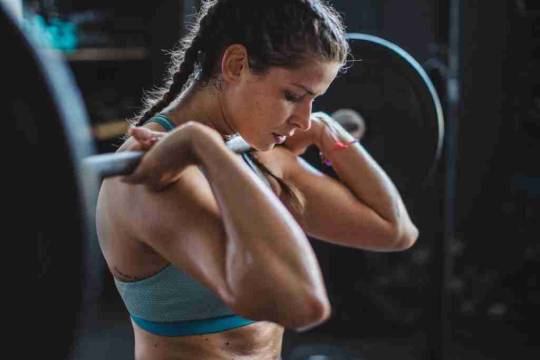
Woman weightlifting with barbell
Lose fat and gain muscle in 8 months, even at 50+!
Tsengas added a little more every week
Tsengas said that she made sure that Corron was progressing in small ways every week. She gradually moved her off machines, and made sure that Corron wrote down her workouts so she could add to them every session. "It's always about increasing, whether it's just doing one extra rep, adding an extra set, changing the tempo, changing the weight," she said. This concept, Tsengas said, is called progressive overload, which is when you continually increase the physical demands on your body in order to maximize gains. Corron said there were many moments where it felt like a workout might be too much for her, but she was often surprised by what her body was ready for. She said she quickly built more confidence seeing how much she was progressing. Tsengas also targeted specific muscle groups that Corron was interested in working on, like the shoulders and glutes. Corron said she began to see more muscle definition about two months in, but noticed the most clear fat loss and muscle gain when Tsengas took photos at eight months. Corron said she also became much more confident in the gym as she saw how effective the program was. She has trained with Tsengas for over a year now. Left: Corron at 0 weeks Right: Corron at 8 months Courtesy of Stefanie Tsengas
Lose fat and gain muscle in 8 months
Consistency and commitment are essential
Consistency is the most important part of starting an exercise program, Tsengas said. Sticking with a program through mental and physical blocks, she said, was Corron's biggest challenge. Corron said training with Tsengas has taught her that progress is often slow, but having more confidence in herself and her body made her trust the process. "From when I originally started with her to now, I do see a lot of change in me that I'm very happy with. But now I just want to keep going, keep going," she said. Read the full article
0 notes
Text
Lose fat and gain muscle in 8 months, even at 50+!

Lose fat and gain muscle in 8 months even at 50+! That's what Haylee Corron did when she walked in to the gym, and sought help from personal trainer Stefanie Tsengas. Taking your time to lose fat is essential to keeping it off, especially for those of us 50 and over! - Personal trainer Stefanie Tsengas said she helped her client Haylee Corron burn fat and build muscle in eight months. - Tsengas first had Corron master the basics and then make small progress every week, she said. - She said she divided workouts into push, pull, and leg exercises to hit every part of the body. 21-year-old Haylee Corron was unsure of herself when she first walked in the gym, according to personal trainer Stefanie Tsengas. The Cleveland-based trainer said in their first meeting a year ago, Corron was insecure about how to start an exercise routine, but wanted to lose fat, build muscle, and gain more confidence in her body. Tsengas said she used Corron's goal to create a twice-a-week workout plan that would hit the entire body and then built gradually on it to get best results. Corron said Tsengas often pushed her past her comfort zone, but showed her just how capable her body was. Not only did Corron exceed Tsengas's expectations at eight months, she also gained the confidence to consistently go to the gym on her own two to three times a week in addition to their sessions together. Stefanie Tsengas
Corron first mastered the basics
As someone new to the gym, Tsengas said Corron's initial program focused on mastering the technique of basic exercises. She said she started Corron mostly on machines because they help stabilize your body and are easier to perform correctly. Tsengas met with Corron two days a week, which she said is the average amount most people commit to. Since Corron wasn't looking to build a specific muscle, Tsengas said she divided her workouts into push, pull, and legs, an effective way to make sure you're hitting every part of the body. Corron did push and pull exercises one day, Tsengas said, and legs on the other. Push exercises mostly target the chest, shoulders, and triceps. Tsengas started Corron with push exercises like the chest press, chest fly, shoulder press, dumbbell lateral raises, front raises, rear delt fly, and cable tricep push-downs. Tsengas said that pull exercises mostly hit the back and biceps. She said lat pull-downs, single-arm dumbbell rows, pull-ups, and bicep curls were all a part of Corron's initial program. A leg day for Corron included exercises like squats, hip thrusts, lunges, leg extensions, and leg curls, she said.

Woman weightlifting with barbell
Lose fat and gain muscle in 8 months, even at 50+!
Tsengas added a little more every week
Tsengas said that she made sure that Corron was progressing in small ways every week. She gradually moved her off machines, and made sure that Corron wrote down her workouts so she could add to them every session. "It's always about increasing, whether it's just doing one extra rep, adding an extra set, changing the tempo, changing the weight," she said. This concept, Tsengas said, is called progressive overload, which is when you continually increase the physical demands on your body in order to maximize gains. Corron said there were many moments where it felt like a workout might be too much for her, but she was often surprised by what her body was ready for. She said she quickly built more confidence seeing how much she was progressing. Tsengas also targeted specific muscle groups that Corron was interested in working on, like the shoulders and glutes. Corron said she began to see more muscle definition about two months in, but noticed the most clear fat loss and muscle gain when Tsengas took photos at eight months. Corron said she also became much more confident in the gym as she saw how effective the program was. She has trained with Tsengas for over a year now. Left: Corron at 0 weeks Right: Corron at 8 months Courtesy of Stefanie Tsengas
Lose fat and gain muscle in 8 months
Consistency and commitment are essential
Consistency is the most important part of starting an exercise program, Tsengas said. Sticking with a program through mental and physical blocks, she said, was Corron's biggest challenge. Corron said training with Tsengas has taught her that progress is often slow, but having more confidence in herself and her body made her trust the process. "From when I originally started with her to now, I do see a lot of change in me that I'm very happy with. But now I just want to keep going, keep going," she said. Read the full article
0 notes
Text
Stash These Essentials in your Gym Bag

Packing your gym bag is a delicate balance. Remember that packing your gym bag is a delicate balance. You don’t necessarily want to feel weighted down by your gear as you head to your cardio or lifting session. You do want to have everything you need before, during and after an effective workout, ready to go by your front door or in the car.

Packing your gym bag is a delicate balance. Take a look at this list to get yourself started, though your must-haves are going to depend on what you’re planning to do and what you need to support your fitness and wellness goals.


- Gym togs and shoes — If you’re unable to come to the gym in your workout clothes every day, you must find room for these. There’s no easier out of a workout than still being in your work clothes. After a full day’s work it can take superhuman resolve to go home, get your clothes and then go back to the gym. - Water bottle — Don’t assume you’ll be able to grab a disposable bottle on the way. Even if you can, it won’t keep the contents as cool as you’d like them to be, and you don’t want to get into this landfill-clogging habit. - Post-workout snacks — Even if you have a routine that includes fresh food to replenish you after beating yourself to a pulp in spin class or a HIIT session, keep a few nonperishable snacks like nuts and seeds, dried fruit, jerky or protein bars to ensure you have something available to you quickly. - Earbuds — A 2021 survey of 2,000 people commissioned by RockMyRun found 65% of respondents have “no motivation” to work out if they aren’t listening to music while working out. Don’t forget to bring your buds with you so you can get caught in a good “jam.” - Towels — It’s best to have two, one for wiping yourself off and the other for wiping equipment off. - Dry shampoo, deodorant and face wipes — You’re probably going to have to stop at the supermarket or pick up the kids after you’re done at least once in a while. Read the full article
0 notes
Text
Managing Your Health with Proper Sleep

by Camille Johnson Managing Your Health with Proper Sleep - You know you feel lousy when you don’t get enough sleep. But did you know that too little sleep can actually have a lasting impact on your mental health? The Crew at Stay Healthy reminds you that sleep deprivation can lead to heightened emotional reactivity, in addition to other mental health consequences, which means that if you are trying to manage your mental health without improving your sleep, you are not doing yourself any favors.

Managing Your Health with Proper Sleep
So how can you boost your emotional health and enhance your sleep quality, all at the same time? By taking advantage of these healthy sleep tips and tricks. Adjust Your Environment You might not give it a lot of thought, so long as you have a bed to sleep on, but your bedroom could be contributing to your sleepless nights. Make sure the space is uncluttered and positive, cool, dark and quiet. Decluttering also helps mitigate stress in your home. If you tend to bring work into your bedroom, find a separate area in the house for it. Mixing your personal and professional affairs can lead your mind in the wrong direction when you’re trying to catch those all-important Zzzs. Keep appropriate boundaries for best results. You may also want to remove carpeting from the bedroom if you have it, as carpet can house allergens which can disrupt your sleep. You may also need to replace the windows if they're leaking outside air/noise, which can also negatively impact sleep. Watch Out for Sneaky Sleep Disruptors You know that having a giant cup of coffee before bedtime is a major “no-no” when you are experiencing restless nights. What you may not know is that there are some less-obvious disruptors that can interfere with your ability to fall and stay asleep. In fact, you may be reading this post on one such culprit: your smartphone. As eMentalHealth.ca explains, smartphones impact sleep because the blue light emitted from screens actually triggers a reaction in your brain similar to the reaction produced by sunlight. What this means is that your brain thinks it’s time to wake up, when you should actually be winding down for the night. To counteract this effect, put down your phone a few hours before bed and keep other screens out of the bedroom. Need more motivation? The overuse of smartphones may also reduce cognitive function and emotional well-being. That’s one more reason to find healthier ways to relax at night! With that in mind, try some mindful meditation to wind down, and make sure you stick to a consistent sleep schedule.



Managing Your Health with Proper Sleep
Know How Much Sleep You Really Need Most people think they need eight hours of sleep per night for a healthy body and mind. In reality, though, getting better sleep may be more important for your well-being than simply getting more sleep. Per CNBC, recent sleep studies showed that individuals who got around 6-7 hours of deep, restful sleep were able to complete tests with more success than those who got more sleep. Deep sleep can be especially important for older adults in terms of cognitive and emotional health, so seniors may need more rest to boost their brains. If you are getting the hours of sleep recommended and still wake up feeling tired, it may also be a good idea to speak with a healthcare professional to address underlying issues and/or rule out the potential for actual sleep disorders. Connect With Professionals If you’ve tweaked both your environment and your lifestyle and you’re still not sleeping, there are a few different professionals who could help you. You could try a sleep specialist, acupuncture, massage therapy or private yoga. All of the tips above can be helpful for improving your sleep, and they can also help improve your mental health. If you really want support for your mental health concerns, though, you should consider speaking with a licensed therapist. If it helps, you can think of therapy as you do checkups with your primary care physician, but know that working with the right therapist is the most effective way to manage and improve your mental health issues. Sleep is one of life’s nonnegotiables, and if you’re suffering with insomnia, the rest of your life will suffer, too. Take steps to address your environment and habits, and if that doesn’t help, reach out to a healthcare professional. Read the full article
0 notes